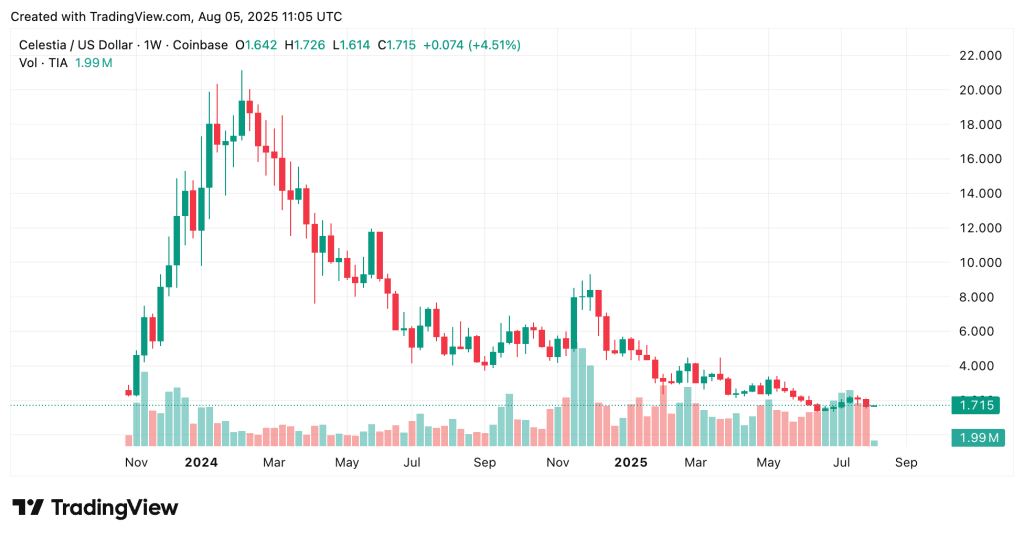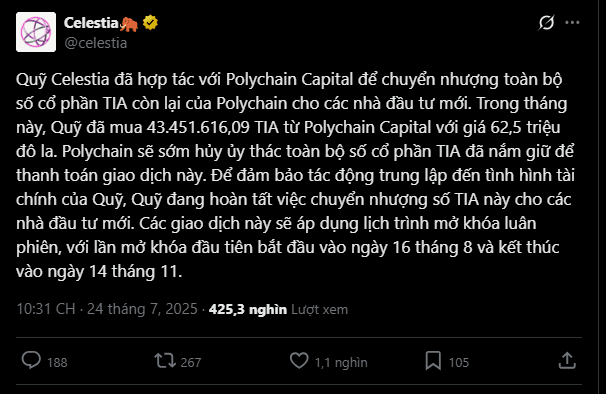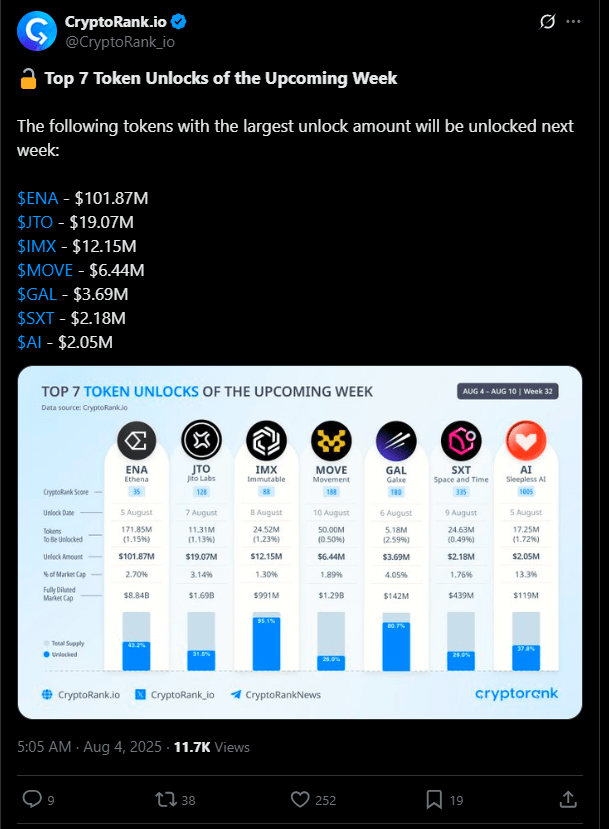Once hailed as a symbol of the "modular blockchain" movement, Celestia's native TIA token has dropped over 90% since its 2024 peak. Although initially inflated by a significant airdrop and promises of decentralization, this substantial decline now raises difficult questions about tokenomics, major unlocks, and the divestment strategies of venture capitalists.

Launched with significant community support at the end of 2023, Celestia's TIA token was distributed to 580,000 users through one of the largest airdrops in recent history. The price of TIA surged to $20 in September 2024, driven by optimism about Celestia's architecture and adoption prospects.
However, as the ownership period began to expire, a large amount of previously locked tokens was put into circulation. According to Tokenomist data, many of these tokens belonged to early supporters and core contributors, including venture capital firms that acquired TIA at a significant discount during early fundraising rounds.
As a result, a wave of massive sell-offs occurred. When these tokens hit the open market, the price of TIA plummeted to a low of just $1.65, down over 90%. However, the market capitalization of this token has increased by 50%, currently hovering around $1.2 billion.
Polychain Exit and the attempt to regain control of Celestia
The turning point came in July when one of Celestia's largest investors, Polychain Capital, fully divested from the project. The Celestia fund announced the buyback of $62.5 million of Polychain's remaining TIA stake at a price of about $1.44 per token, close to the market price at the time.
In an effort to stabilize the token economy, the fund plans to redistribute the repurchased tokens according to a new continuous unlocking schedule, starting from August 16 and ending on November 14. This revised structure is part of a broader strategy to manage inflation and restore investor confidence.

Polychain's handling of staking rewards has faced significant criticism. While the initial investment remains locked, on-chain analysts estimate that the company has liquidated over $240 million in TIA, primarily from staking profits. Many believe this heavy sell-off was due to exploiting a flaw in the reward system, providing asymmetric benefits to early participants while disadvantaging retail participants.
In response, Celestia introduced a staking reform as part of the upcoming "Lotus" mainnet upgrade. This update has implemented a locking mechanism, whereby early investors will no longer be able to withdraw their staking funds early, ensuring access to rewards that align with a long-term commitment to the network.
From boom to bust: The collapse of TIA illustrates the fragility of new Tokenomics
The recent decline in the price of Celestia's TIA token reflects a common pattern that is challenging newer Layer 1 and Layer 2 projects, where aggressive unlocking schedules and poor liquidity management are dissipating initial hype.
The most notable collapse came from Blast, which initially attracted over $2.7 billion in Total Value Locked (TVL), becoming the sixth-largest blockchain within six months. At its peak, Blast boasted over 200 dApps deployed and 180,000 daily active users. However, this growth momentum did not last long.
A large unlocking event in June 2024, with over 10.5 billion tokens, accounting for more than half of the supply, flooded the market, driving prices down to record lows. As of today, TVL has decreased by over 96% to just $105 million, with daily activity dropping to only 3,800 users.
Additionally, the price of Berachain fell 50% within hours of its launch due to insider trading allegations and an unpopular airdrop that saw some users receiving millions of dollars while others received nothing.
Similarly, Omni Network's token fell over 50% on its launch day. With 15.98 million OMNI unlocked on May 3, worth nearly $40 million at current prices, the downtrend appears likely to continue. OMNI has lost over 92% from its all-time high of $53.81.
These failures highlight the increasing skepticism towards new tokens prioritizing initial liquidity and higher valuations over sustainable ecosystem growth.
Token unlocks continue to pressure the market as major projects prepare for volatility
The cryptocurrency market is bracing for another week of volatility as large token unlocks threaten to shake investor sentiment. From August 4 to August 10, 2025, several prominent projects, including Ethena (ENA), Jito Labs (JTO), and Immutable (IMX), will release millions of tokens, potentially creating new waves of volatility.

Ethena leads the list with a plan to unlock 171.85 million ENA tokens on August 5, estimated to be worth $101.87 million, equivalent to 2.70% of the market capitalization. The price of ENA has dropped -61.43% from its all-time high of $1.52 and is currently trading at $0.5883. The project previously conducted a widely followed airdrop in April 2024, distributing 750 million tokens to participants. However, the new supply could further pressure the price if recipients decide to sell to unlock.
On August 7, Jito Labs will release 11.31 million JTO tokens, valued at $19.07 million and accounting for 3.14% of the market capitalization. This Solana-based DeFi project distributed approximately $225 million in tokens during the December 2023 airdrop. Since then, the price of JTO has dropped -70.13% from its all-time high of $5.61, currently trading at $1.69, raising concerns about ongoing downside risks.
Immutable will unlock IMX tokens worth $12.15 million on August 8, equivalent to 1.30% of the market capitalization. Although more than 95.1% of the total supply of IMX has been released, the unlocking remains significant as IMX has plummeted -94.57% from its peak of $9.50 and is currently trading at $0.5173. The volatility of IMX reflects the overall trend of many airdrop projects — a brief initial frenzy followed by a strong sell-off after unlocking.
These upcoming unlocks occur at a time when market confidence in airdrop-distributed tokens continues to wane. With airdrop recipients often acting as active sellers, future unlocks, especially in a down or sideways market, may increase downward pressure across the altcoin sector.
